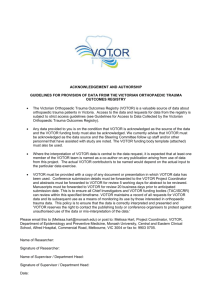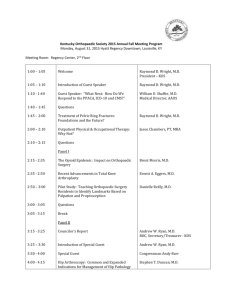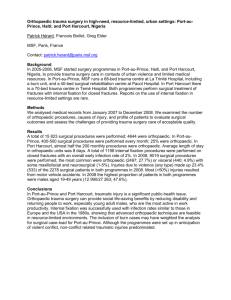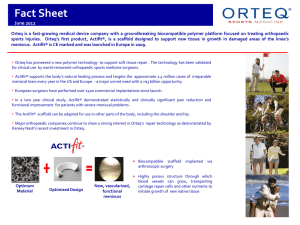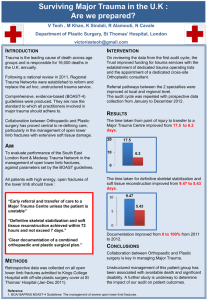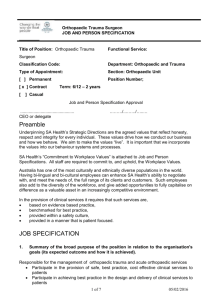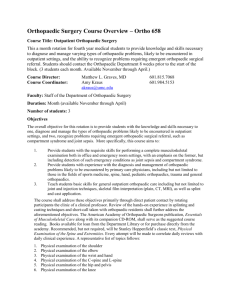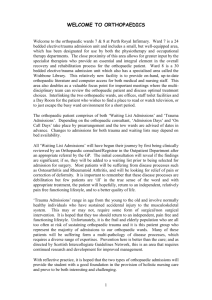HIP DISLOCATIONS
advertisement
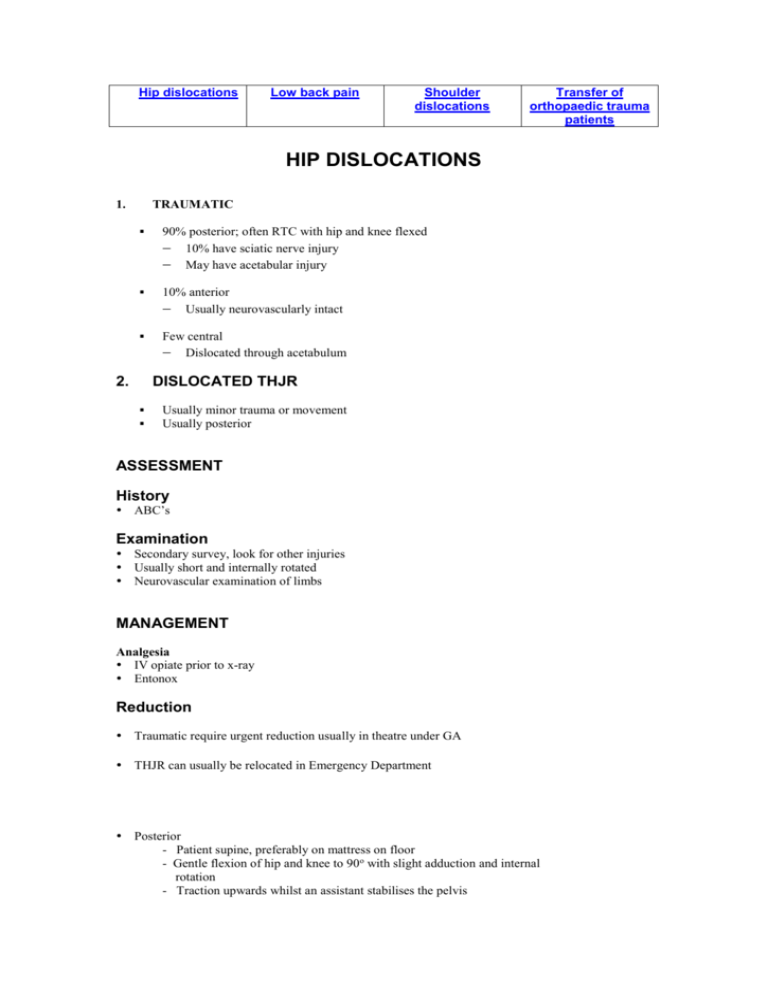
Hip dislocations Low back pain Shoulder dislocations Transfer of orthopaedic trauma patients HIP DISLOCATIONS 1. TRAUMATIC 90% posterior; often RTC with hip and knee flexed 10% have sciatic nerve injury May have acetabular injury 10% anterior Usually neurovascularly intact Few central Dislocated through acetabulum 2. DISLOCATED THJR Usually minor trauma or movement Usually posterior ASSESSMENT History ABC’s Examination Secondary survey, look for other injuries Usually short and internally rotated Neurovascular examination of limbs MANAGEMENT Analgesia IV opiate prior to x-ray Entonox Reduction Traumatic require urgent reduction usually in theatre under GA THJR can usually be relocated in Emergency Department Posterior - Patient supine, preferably on mattress on floor - Gentle flexion of hip and knee to 90o with slight adduction and internal rotation - Traction upwards whilst an assistant stabilises the pelvis - Rotation can be applied gently if required but forceful rotation should be avoided as it may result in a femoral neck fracture Anterior - Patient supine - Hip and knee flexed to 900 with assistant stabilising pelvis - Femur rotated to neutral - Traction upwards (i.e. vertically) - May require gentle internal rotation (avoid adduction which can fracture the femur) - Lower the leg whilst maintaining traction REASSESSMENT Examine hip Neurovascular examination X-ray DISPOSITION 1. Traumatic Admission 2. THJR Zimmer splint to prevent re-dislocation of hip Orthopaedic Clinic in one week or discuss with orthopaedics if frequent occurrence or xray shows loosening of prosthesis. LOW BACK PAIN Patients presenting to the Emergency Department can be divided into 3 broad groups : Those with acute low back pain Those with recurrent low back pain Those with chronic low back pain Epidemiology Commonest cause of disability in the under 45 9 out of 10 patients with acute back pain experience resolution of pain within 4 weeks without specific intervention APPROACH TO PATIENT WITH BACK PAIN Aim To identify signs of serious disease Prevent long term disability and chronicity Promote early return to normal level of physical activity History – identify Clinical Examination Risk factors for serious disease Limitation of activity Similar previous episodes Factors that might limit early return to normal activity Identify neurological deficit especially Cauda Equina Syndrome Nerve root lesions – L5 or S1 roots most commonly involved Temperature must be taken Bladder and bowel function needs to be documented Anal tone and saddle area sensation should be examined Red Flags Cauda Equina Syndrome Significant trauma Weight loss History of carcinoma Fever IV drug use Steroid use Patient over 50 years Severe unremitting night-time pain Pain that worsens when patient lies down Investigations – depending on red flags identified FBC – if infection suspected ESR – if infection, carcinoma suspected XRAY – if tumour, infection or significant trauma CT ) in consultation with ED consultant or orthoMRI ) paedic registrar Management Provide assurance and explanation If history and examination negative for serious problem further investigation not warranted, encourage activity and continuance of usual daily activities. Control symptoms : Provide simple analgesia. - Paracetamol, codeine Voltaren Avoid morphine and pethidine. If drug seeking not suspected, a good dose of narcotic will enable patient to mobilise while in the department. Diazepam 5 mg orally can be given as a muscle relaxant Use of muscle relaxants – diazepam (supported by few studies ) should be short term / minimum dose Encourage patient to mobilise in the department. Patient should be discharged with advice to watch for neurological esp cauda equina symptoms. Work activities modified e.g. lifting, bending, twisting, alternative duties Bed rest for more than 2 days to be discouraged Patients suffering from chronic back pain are difficult to manage. They are usually on full analgesic therapy. Adding a TCA may be beneficial. Patient should be referred to the Pain Clinic. Referred pain requires management of the primary disease process Admission criterion Refer urgently to orthopaedic services if Cauda equina lesion, or other significant neurological deficit, multiple root involvement. Infection Tumour Trauma, significant or inability to mobilise with analgesia Admit to medical short stay ward / HSE if Elderly, unable to mobilise. No home support Treat on its own merit Pain referred by other organ pathology Follow up Provide a discharge letter Instruct patient to see GP Physiotherapy is prescribed by GP if necessary DIFFERENTIAL DIAGNOSIS ACUTE BACK PAIN Local Causes Important Cause of Referred Pain Acute non-specific soft tissue / musculoligamentous discord Prolapsed interverterbral disc Trauma – fractures, soft tissue injury Tumour Infection Metabolic bone disease Retroperitoneal – pyelonephritis, renal colic Abdominal – cholecystitis, pancreatitis, peptic ulcer, aortic aneurysm, dissection of the aorta. H zoster SHOULDER DISLOCATIONS ASSESSMENT History First vs recurrent Examination Deformity Neurovascular function X-rays For ALL first Traumatic recurrent Views: Axillary lateral view – detects anterior and posterior dislocations Transcapular lateral – if axillary lateral is impossible because of pain. NB corocoid points anteriorly, allowing the relationship of the humeral head to the corocoid to be deduced. MANAGEMENT Analgesia IV opiod prior to x-ray + entonox Sedation May be required Reduction Many methods have been described, having a success of 70 – 90% each 1. Milch Method 2. Suitable for anterior or posterior dislocations Well tolerated. Often reduces without a palpable clunk Patient supine Operator braces one thumb against humeral head Slow, gentle abduction to overhead position External rotation with gentle traction Scapula Manipulation 3. Well tolerated Difficult in obese or very muscular patients Patient prone Arm hanging over side of the trolley with a sandbag, or traction provided by an assistant After 5 minutes, the inferior angle of the scapular is pushed medially. Kocher Indicated in muscular patients or when the presentation is delayed Painful Increased incidence of injuries to humerus and labium 4. Patient semi-erect Elbow flexed Caudal traction on flexed elbow External rotation of arm Arm adducted across chest Internal rotation of arm to place hand on opposite shoulder Traction Well tolerated Often no analgesia or sedation required Patient supine, preferably on mattress on floor Traction vertically applied to arm whilst patient relaxes shoulder into the bed REASSESSMENT Reassess for neurovascular injury X-ray FOLLOW UP Broad arm sling Orthopaedic Clinic in one week TRANSFER OF ORTHOPAEDIC TRAUMA PATIENTS Purpose Protocol for transfer of Orthopaedic Trauma Patients Scope Between Auckland Hospital Department of Emergency Medicine and Middlemore Hospital Policy statement(s) A. Conditions that should not be transferred: 1. 2. 3. 4. Open fractures - except phalanges Unreduced dislocations of any kind Unstable spinal or pelvic injuries Femoral shaft fractures 5. Patients with a significant arterial injury or compartment syndrome B. Conditions that could be transferred following assessment by an Orthopaedic Registrar / Consultant or Emergency Medicine Consultant: 1. Stable spinal injuries 2. Stable pelvic injuries When a particular clinical case falls outside the criteria of this protocol the Orthopaedic Registrar / Consultant involved can request an Orthopaedic assessment prior to transfer.
